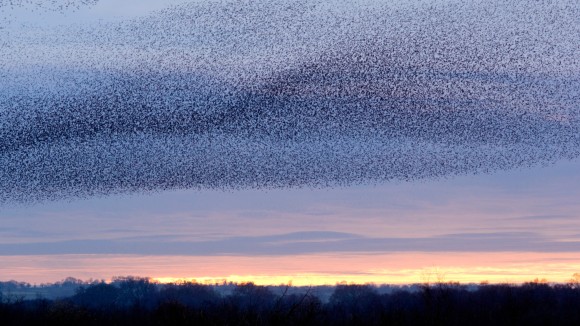Swarm Structure Simulation

After reading the book The Rules of the Flock I got inspired to test some ideas of the book. Basically a swarm behavior is defined when individual agents, following a simple set of local rules without a central leader, produce complex and intelligent collective patterns.
To see these rules in action, I developed the interactive Python simulation detailed below. Using Matplotlib, the simulation visualizes a flock of ‘boids’. You can use the sliders to change the weight of each rule in real-time—crank up ‘Cohesion’ to see the flock tighten, or increase ‘Separation’ to watch them spread out. You can also interact directly with the swarm using your mouse, acting as a predator to scatter the flock or a point of interest to draw them in. It’s a fascinating look at how complex, life-like motion can emerge from a few simple, local instructions.
import numpy as np
import matplotlib.pyplot as plt
import matplotlib.animation as animation
from matplotlib.widgets import Slider
# --- Simulation Configuration ---
N_BOIDS = 150
WIDTH, HEIGHT = 1200, 800
PERCEPTION_RADIUS = 70
MAX_SPEED = 5.0
MIN_SPEED = 2.0
MOUSE_INFLUENCE_RADIUS = 150.0
# --- Weights for the rules ---
INITIAL_SEPARATION_WEIGHT = 1.5
INITIAL_ALIGNMENT_WEIGHT = 1.0
INITIAL_COHESION_WEIGHT = 1.0
MOUSE_ATTRACT_WEIGHT = 2.5
MOUSE_REPEL_WEIGHT = 3.0
INITIAL_COND = 'random' # circle, random, grid
class Boids:
"""
A class to manage the state and behavior of a flock of boids.
"""
def __init__(self, count, width, height, initial_condition='random'):
self.width = width
self.height = height
self.count = count
self.positions, self.velocities = self._initialize_boids(initial_condition)
self.weights = {
'separation': INITIAL_SEPARATION_WEIGHT,
'alignment': INITIAL_ALIGNMENT_WEIGHT,
'cohesion': INITIAL_COHESION_WEIGHT
}
self.mouse_pos = None
self.mouse_mode = None # 'attract' or 'repel'
def _initialize_boids(self, condition):
"""Sets the initial positions and velocities of the boids."""
if condition == 'circle':
center = np.array([self.width / 2, self.height / 2])
radius = min(self.width, self.height) / 4
angles = np.linspace(0, 2 * np.pi, self.count)
positions = center + radius * np.c_[np.cos(angles), np.sin(angles)]
velocities = (np.c_[-np.sin(angles), np.cos(angles)]) * MIN_SPEED
elif condition == 'grid':
grid_size = int(np.ceil(np.sqrt(self.count)))
x = np.linspace(self.width/4, 3*self.width/4, grid_size)
y = np.linspace(self.height/4, 3*self.height/4, grid_size)
xx, yy = np.meshgrid(x, y)
positions = np.c_[xx.ravel(), yy.ravel()][:self.count]
velocities = np.full((self.count, 2), [0, -MIN_SPEED])
else: # 'random'
positions = np.random.rand(self.count, 2) * np.array([self.width, self.height])
velocities = (np.random.rand(self.count, 2) - 0.5) * MAX_SPEED
return positions, velocities
def _apply_rules(self):
"""Applies boid rules to calculate acceleration."""
deltas = self.positions[:, np.newaxis, :] - self.positions[np.newaxis, :, :]
distances = np.sqrt(np.sum(deltas**2, axis=2))
separation_vec = np.zeros_like(self.positions)
alignment_vec = np.zeros_like(self.positions)
cohesion_vec = np.zeros_like(self.positions)
neighbor_mask = (distances > 0) & (distances < PERCEPTION_RADIUS)
for i in range(self.count):
neighbors = neighbor_mask[i]
if not np.any(neighbors):
continue
close_mask = (distances[i] > 0) & (distances[i] < PERCEPTION_RADIUS / 2)
if np.any(close_mask):
avg_pos_close = np.mean(self.positions[close_mask], axis=0)
separation_vec[i] = self.positions[i] - avg_pos_close
alignment_vec[i] = np.mean(self.velocities[neighbors], axis=0)
avg_pos_all = np.mean(self.positions[neighbors], axis=0)
cohesion_vec[i] = avg_pos_all - self.positions[i]
for vec in [separation_vec, alignment_vec, cohesion_vec]:
norm = np.sqrt(np.sum(vec**2, axis=1))[:, np.newaxis]
non_zero_mask = norm.flatten() > 0
if np.any(non_zero_mask):
vec[non_zero_mask] /= norm[non_zero_mask]
mouse_steer = np.zeros_like(self.positions)
if self.mouse_pos is not None:
mouse_delta = self.mouse_pos - self.positions
mouse_dist = np.sqrt(np.sum(mouse_delta**2, axis=1))
influence_mask = mouse_dist < MOUSE_INFLUENCE_RADIUS
if self.mouse_mode == 'attract':
mouse_steer[influence_mask] = mouse_delta[influence_mask] * MOUSE_ATTRACT_WEIGHT
elif self.mouse_mode == 'repel':
repel_force = (MOUSE_INFLUENCE_RADIUS - mouse_dist[influence_mask, np.newaxis]) / MOUSE_INFLUENCE_RADIUS
mouse_steer[influence_mask] = -mouse_delta[influence_mask] * MOUSE_REPEL_WEIGHT * repel_force
acceleration = (separation_vec * self.weights['separation'] +
alignment_vec * self.weights['alignment'] +
cohesion_vec * self.weights['cohesion'] +
mouse_steer)
return acceleration
def update(self):
"""Updates the position and velocity of each boid."""
acceleration = self._apply_rules()
self.velocities += acceleration
speeds = np.sqrt(np.sum(self.velocities**2, axis=1))
speed_mask_max = speeds > MAX_SPEED
speed_mask_min = speeds < MIN_SPEED
if np.any(speed_mask_max):
self.velocities[speed_mask_max] *= (MAX_SPEED / speeds[speed_mask_max, np.newaxis])
if np.any(speed_mask_min):
self.velocities[speed_mask_min] *= (MIN_SPEED / speeds[speed_mask_min, np.newaxis])
self.positions += self.velocities
self.positions[:, 0] = np.mod(self.positions[:, 0], self.width)
self.positions[:, 1] = np.mod(self.positions[:, 1], self.height)
# --- Visualization and Interactivity ---
boids = Boids(N_BOIDS, WIDTH, HEIGHT, initial_condition=INITIAL_COND)
fig, ax = plt.subplots(figsize=(12, 9))
# Leave space at the bottom for sliders and description text
plt.subplots_adjust(bottom=0.3, left=0.1)
ax.set_xlim(0, WIDTH)
ax.set_ylim(0, HEIGHT)
ax.set_xticks([])
ax.set_yticks([])
ax.set_facecolor('k')
fig.set_facecolor('k')
quiver = ax.quiver(boids.positions[:, 0], boids.positions[:, 1],
boids.velocities[:, 0], boids.velocities[:, 1],
color='cyan', headwidth=2, headlength=3)
mode_text = ax.text(10, HEIGHT - 20, "Mode: Normal", color='white', fontsize=12)
# --- Mouse Click Event Handler ---
def on_click(event):
if event.inaxes:
boids.mouse_pos = np.array([event.xdata, event.ydata])
if event.button == 1:
boids.mouse_mode = 'attract'
mode_text.set_text("Mode: Attract (Left-Click)")
elif event.button == 3:
boids.mouse_mode = 'repel'
mode_text.set_text("Mode: Repel (Right-Click)")
elif event.button == 2:
boids.mouse_mode = None
boids.mouse_pos = None
mode_text.set_text("Mode: Normal (Middle-Click)")
fig.canvas.mpl_connect('button_press_event', on_click)
# --- Sliders and Description Text ---
ax_sep = plt.axes([0.25, 0.18, 0.65, 0.03])
ax_ali = plt.axes([0.25, 0.13, 0.65, 0.03])
ax_coh = plt.axes([0.25, 0.08, 0.65, 0.03])
slider_sep = Slider(ax_sep, 'Separation', 0.1, 5.0, valinit=INITIAL_SEPARATION_WEIGHT, color='c')
slider_ali = Slider(ax_ali, 'Alignment', 0.1, 5.0, valinit=INITIAL_ALIGNMENT_WEIGHT, color='c')
slider_coh = Slider(ax_coh, 'Cohesion', 0.1, 5.0, valinit=INITIAL_COHESION_WEIGHT, color='c')
# Add the text area for descriptions
description_text = fig.text(
0.5, 0.02,
"Move a slider to see its description.",
color='yellow', ha='center', va='bottom', fontsize=10
)
# Descriptions for each slider
descriptions = {
'separation': "Separation: Controls how strongly boids steer to avoid crowding neighbors. Higher values prevent collisions.",
'alignment': "Alignment: Controls how strongly boids steer to match the heading of their neighbors. Higher values create more parallel flight.",
'cohesion': "Cohesion: Controls how strongly boids steer towards the center of their neighbors. Higher values create tighter flocks."
}
# Functions to update weights AND the description text
def update_separation(val):
boids.weights['separation'] = val
description_text.set_text(descriptions['separation'])
def update_alignment(val):
boids.weights['alignment'] = val
description_text.set_text(descriptions['alignment'])
def update_cohesion(val):
boids.weights['cohesion'] = val
description_text.set_text(descriptions['cohesion'])
slider_sep.on_changed(update_separation)
slider_ali.on_changed(update_alignment)
slider_coh.on_changed(update_cohesion)
# --- Animation Loop ---
def animate(frame):
boids.update()
quiver.set_offsets(boids.positions)
quiver.set_UVC(boids.velocities[:, 0], boids.velocities[:, 1])
ax.set_title(f"Interactive Swarm Simulation", color='white')
return quiver, mode_text, description_text
ani = animation.FuncAnimation(fig, animate, frames=200, interval=30, blit=False)
plt.show()